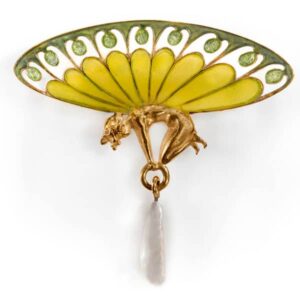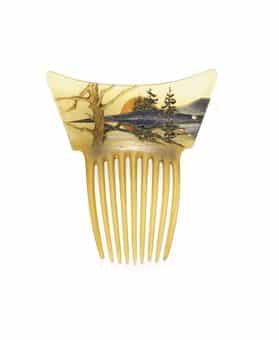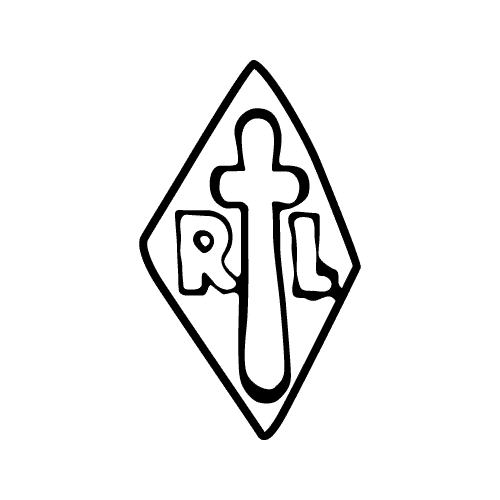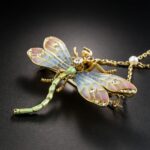(1881-Present)

Photo Courtesy of © The Richard H. Driehaus Museum.
In 1876 René Lalique (1860-1945) began his career as an apprentice to the eminent Parisian goldsmith Louis Aucoc. Though keen to learn the trade, Lalique was more interested in the general arts. He enrolled at L’École des Arts Décoratifs from 1876-78 and then traveled to London, where he attended the School of Art at Sydenham from 1878-80. Returning to Paris, he studied sculpture with Justin Lequien and designed textiles for a relative.1 In 1881, Lalique started to design and manufacture jewelry, selling the pieces to firms such as Aucoc, Boucheron, and Cartier.
In 1885, he opened a boutique of his own and enjoyed ten years of unprecedented creativity and success. Adopting the themes, techniques, and materials of the emerging Art Nouveau movement, Lalique refined them to their apogee. His jewelry featured sinuous lines, creeping branches, vines, flowers, and fetching scantily clad women. The pieces were embellished with organic and unusual gemstones as well as delicately shaded plique-à-jour enamelling. In 1900, critics at Paris’s Exposition Universelle unanimously lauded his jewels, singling them out as the finest examples of contemporary design.

Photo Courtesy of Christie’s.
Around the same time, he began drawing and fabricating glass objects, an enterprise to which he would fully devote himself in the 1920s. In 1925, at the Exposition des Arts Décoratifs et Industriel, the exposition for which the Art Deco design era was named, his glass objects were again the talk of the show. Though refusing to work with gold in his later years, Lalique continued creating brooches and pendants in glass.
His workshops were closed in 1937 and 1940. When Lalique died in 1945, his firm lived on, with his son Marc succeeding him. In 1977, daughter Marie-Claude picked up the mantel. The firm continues to this day, producing fine crystal objects.
Maker's Marks & Timeline
Lalique, René
| Country | |
|---|---|
| City | Paris |
| Symbol | cartouche, cross, diamond, frame, kite, lozenge, rhombus |
| Shape | cartouche, cross, diamond, frame, kite, lozenge, rhombus |
| Era | (1860-1945) |
Specialties
- Bijoux sculptés
- Medallist
- Use of Champlevé & Plique-à -Jour enamel was unrivaled.
- Art Nouveau pioneer, leading jeweler of the Belle Epoque.
Materials
- Horn.
- Crystal.
- Enamel.
- Cut glass.
1860
- Birth of René Lalique
1876
- Apprentice to Louis Aucoc at age sixteen.
1878
- Studied graphic design in London.
1880
- Worked with Auguste Petit.
- Designed fans, fabrics and wallpaper.
- Independent designer for Aucoc, Sestape, Cartier, Gariod and others
1882
- Independent jewelry designer.
1884
- Lalique’s Arts & Crafts exhibition catches the eye of Alphonse Fouquet
- Went into business with M. Varenne – signed Lalique et Varene, rue de Vaugirard 84
1885
- Begins fabricating in the style that would make him famous.
- Place Baillon location of Destape assumed by Lalique
- Creates for Cartier, Boucheron and Vever
1887
- Boucheron buys ‘Flight of Swallows’ Parure.
- Relocates to rue du Quatre Septembre, then rue Therése
1889
- Exposition Universelle features his work anonymously in Vever and Boucheron’s displays.
c.1890
- Begins experiments with glass and enamel, developing his new style
1894
- Designer of jewelry for Sarah Bernhardt & Maison de l’Art Nouveau.
1897
- Legion of Honour’s Croix de Chevalier.
1900
- Lalique displays at Universal Exhibition (Paris) to great acclaim.
- Grand Prix, Order of the Legion of Honour
1905
- Opens at Place Vendôme
c.1908
- Begins to operate Combs-la-Ville Glassworks
1918
- Founds Wingen-sur-Moder Glassworks
1925
- Exposition Internationale des Arts Decoratifs et Industriels exhibits “The Springs of France”.
- Begins manufacturing objet and statuettes in the “Lalique” Style.
1945
- Death of René Lalique.
- After his death, firm Run By Son Marc and later Marie-Claude.
Sources
- Bayer, Patricia & Mark Waller. The Art of Rene Lalique. Secaucus: The Wellfleet Press, 1988.
- Becker, Vivienne. Art Nouveau Jewelry. New York: E.P. Dutton, 1985.
- Sataloff, Joseph. Art Nouveau Jewelry: A Practical Guide to Its History and Beauty with Pictures of Over 150 Pieces of Jewelry and a Compendium of International Jeweler’s Marks. Bryn Mawr, PA: Dorrance and Co. Inc., 1984.
- Vever, Henri. French Jewelry of the Nineteenth Century. Translated by Katherine Purcell. London: Thames & Hudson, 2001 (1906-8), 1091.
Related Reading
Notes
- Bayer, 8.↵








